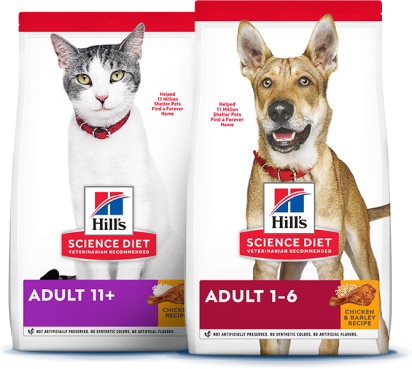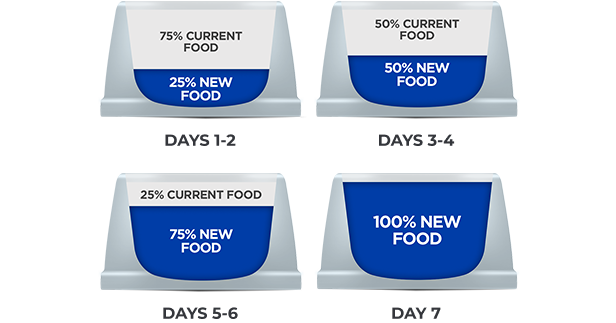
-
Hitta rätt mat för ditt husdjurGör det här testet för att se vilket foder som kan vara bäst för din pälskling.Hitta rätt mat för ditt husdjurGör det här testet för att se vilket foder som kan vara bäst för din pälskling.Utvalda produkter
 Healthy Mobility Medium Adult Hundfoder
Healthy Mobility Medium Adult HundfoderHill's Science Plan Healthy Mobility Medium Breed Adult Hundfoder med kyckling erbjuder en avancerad nutrition för att stödja ledhälsa och förbättra rörligheten. provides advanced nutrition to support joint health and improve mobility.
Handla nu Hypoallergenic Adult Hundfoder
Hypoallergenic Adult HundfoderHill's Science Plan Hypoallergenic Adult våtfoder med lax är ett komplett helfoder av högsta kvalitet för alla vuxna hundar från 1 år och uppåt. Detta läckra våtfoder i burk är speciellt sammansatt för hundar med känslig hud och mage. Den innehåller en enda animalisk proteinkälla och är spannmålsfri.
Handla nu Hypoallergeniskt hundfoder för vuxna hundar med lax
Hypoallergeniskt hundfoder för vuxna hundar med laxHILL'S SCIENCE PLAN Hypoallergenic Large Breed Adult hundfoder med lax är ett komplett foder för vuxna hundar av stora raser i åldern 1–5 år. Det är särskilt framtaget för hundar med känslig hud och mage, med begränsade mängder högkvalitativa och nya proteinkällor samt utan spannmål.
Handla nuHälsotillståndUtvalda produkter Sterilised Kattungefoder
Sterilised KattungefoderHill's SCIENCE PLAN Sterilised Kitten kattungefoder är skapat med Hill´s unika förståelse för de specifika behov som kastrerade kattungar har. Det bidrar med hög proteinkvalitet för muskelutveckling, med kontrollerat fett för att förebygga risk för övervikt efter kastrering. Dessutom har det en unik blandning av antioxidanter för att främja ett hälsosamt immunsystem för att stöjda din kattunges tillväxt.
Handla nu Hill's Science Plan SENIOR VITALITY KATTFODER Kyckling, med laxHandla nu
Hill's Science Plan SENIOR VITALITY KATTFODER Kyckling, med laxHandla nu Hill's Science Plan Mature Adult Kattfoder Tonfisk
Hill's Science Plan Mature Adult Kattfoder TonfiskHill's Science Plan Adult kattfoder med lax är ett helfoder för äldre katter, speciellt utformat med ActivBiome+ Multi-Benefit teknologi.
Detta foder främjar ett värdigt åldrande hos katter och innehåller en synergistisk blandning av ingredienser som bidrar till att upprätthålla energi- och aktivitetsnivån.Handla nu -
Till hundägare
- Tips och artiklar
-
Hälsokategori
- Vikthantering
- Miljö- och foderöverkänslighet
- Urinvägar
- Matsmältning
- Leder
- Njurar
-
Hundens livsstadium
- Näring för valpar
- Näring för vuxna katter
- Näring för seniorer
Till kattägare- Tips och artiklar
-
Hälsokategori
- Vikthantering
- Hud- & foderöverkänslighet
- Urinvägar
- Matsmältning
- Njurar
-
Kattens livsstadium
- Näring för kattungar
- Näring för vuxna
- Näring för seniorer
Utvalda artiklar Virtual Vet Visits: What You Need to Know
Virtual Vet Visits: What You Need to KnowLearn the ins and outs of a televet appointment before you talk to a vet online.
Läs mer Viktförändringar hos hundar och katter - kan det vara ett sköldkörtelproblem?
Viktförändringar hos hundar och katter - kan det vara ett sköldkörtelproblem?En viktförändring kan tyda på ett problem med sköldkörteln. Läs mer om tecken, orsaker och vad du kan göra åt det.
Läs mer Kristaller och stenar i hund- och katturin
Kristaller och stenar i hund- och katturinLäs om orsaker till och behandlingar av kristaller i hund- och katturin för att bibehålla hundens eller kattens hälsa. För expertråd om urinvård, besök Hill's Pet Sverige.
Läs mer -
Feed with confidence
How to switch or transition your pets’ food
Feed with confidence
How to switch or transition your pets’ food

Upgraded Science Diet formulas are on the way
Coming soon, select Science Diet foods will have updated formulas with breakthrough innovations developed by our team of over 200 veterinarians and nutritionists.
Featuring our latest science — ActivBiome+ Ingredient Blend


Be sure to plan ahead for a seamless transition to your upgraded formula.

Transitioning your pet to a new food
There will likely be a time when your pet will need to switch to a new food, whether it’s to a therapeutic nutrition, a new formula or they just need a food that better suits their life stage. Pets should gradually transition to new food to avoid stomach upset. Here are some tips for transitioning your pet to a new food.
Transitioning your pet to a new food
There will likely be a time when your pet will need to switch to a new food, whether it’s to a therapeutic nutrition, a new formula or they just need a food that better suits their life stage. Pets should gradually transition to new food to avoid stomach upset. Here are some tips for transitioning your pet to a new food.



Determine the right amount per serving

Follow this 7-day transition schedule


Follow this 7-day transition schedule



Consider making your pet’s dry food more like wet food
While it’s not a necessity, some pets are a little more stubborn than others, and a little wet food can make all the difference. To avoid going over their daily caloric intake requirements, be sure to check with your vet on the proper serving sizes.

Consider making your pet’s dry food more like wet food
While it’s not a necessity, some pets are a little more stubborn than others, and a little wet food can make all the difference. To avoid going over their daily caloric intake requirements, be sure to check with your vet on the proper serving sizes.
- Softening dry food
- Adding taste enhancers
Combine wet & dry food

Add the following “enhancers” to make your pet’s dry food more appealing





Hitta rätt foder för din hund eller katt
Rätt näring är avgörande för att hundar och katter ska leva lyckliga och friska liv. Se vilka foder som passar din hunds eller katts unika näringsbehov här.

